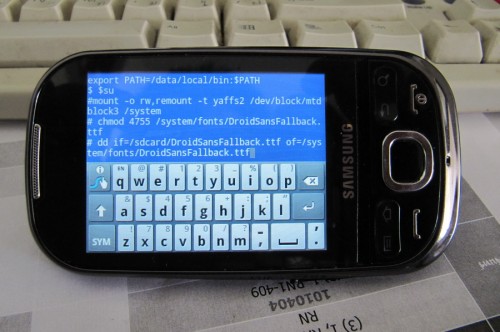
Notes: I am writing this guide from memory and it shouldn’t be considered definitive (or even accurate, ha ha). Also, I get this sort of stuff done with heavy googling and then lots of trial and error, an approach that often ends in tears. It happened to work for me this time, but only after trying several different approaches and tools. It might not work for you and I accept no responsibility for that or what it might entail: Worst case, you might brick your phone.
That being said, it has made the Galaxy 5 one of the best values currently on the Thai smartphone market – cheap (about 5,000 Baht new last time I checked), fast, and installable with almost any app.
Credit where credit is due: The majority of the Thai font install procedure below was adapted from NexusOneHacks.net.
One last thing, is it truly necessary to flash your firmware in order to install the fonts? Maybe not, but it was for me. I was previously using firmware I5500LUYJP2 from this page. I tried the same font installation procedure described below and it did not work until I tried different firmware..
—————-
1. Download firmware and follow the Flashing Instructions on this page: MAD ROM 2.3 Extreme App2SD Edition. If you don’t know how to use ODIN, etc., this guide can help you (just remember to use the firmware you just downloaded instead of the one linked in the guide).
2. After setup is complete, root your phone with Universal Androot (I’ve found that often the first try isn’t successful. Just try again.)
3. Next, install Terminal Emulator on your Galaxy 5.
4. Since Froyo lacks copy functionality from shell (for whatever stupid reason), you need to install busybox. Click this link to download busybox. Then copy it into the root directory of your SD card.
5. Make a new directory in the root of your SD card and name it font. Download this zip file, which contains the Droid Sans font files with Thai support. Unzip it, and copy all the .ttf files into the font directory you made.
6. Open Terminal Emulator on your phone, type each line below (without the $ or # symbols that are there to indicate a new line as shown in the application) and press the enter key.
$ su
Note: This command should open a prompt that asks if you want to grant Superuser privileges to the Terminal Emulator application. Click yes. After this point, the $ symbol before each new command should automatically change to a # symbol. This indicates superuser status.
# mount -o rw,remount -t yaffs2 /dev/block/mtdblock4 /system
# mkdir /data/busybox
# cat /sdcard/busybox > /data/busybox/busybox
# chmod 755 /data/busybox/busybox
# mkdir /data/local
# cd /data/busybox
# ./busybox –install
(That’s 2 dashes before install!!!)
# cp /sdcard/font/* /system/fonts
—————-
The fourth line from the bottom with the mkdir command probably isn’t necessary, but even if it isn’t, it will just return a harmless error. Also, the busybox install returned a bunch of errors for me, but seemed to work out in the end.
